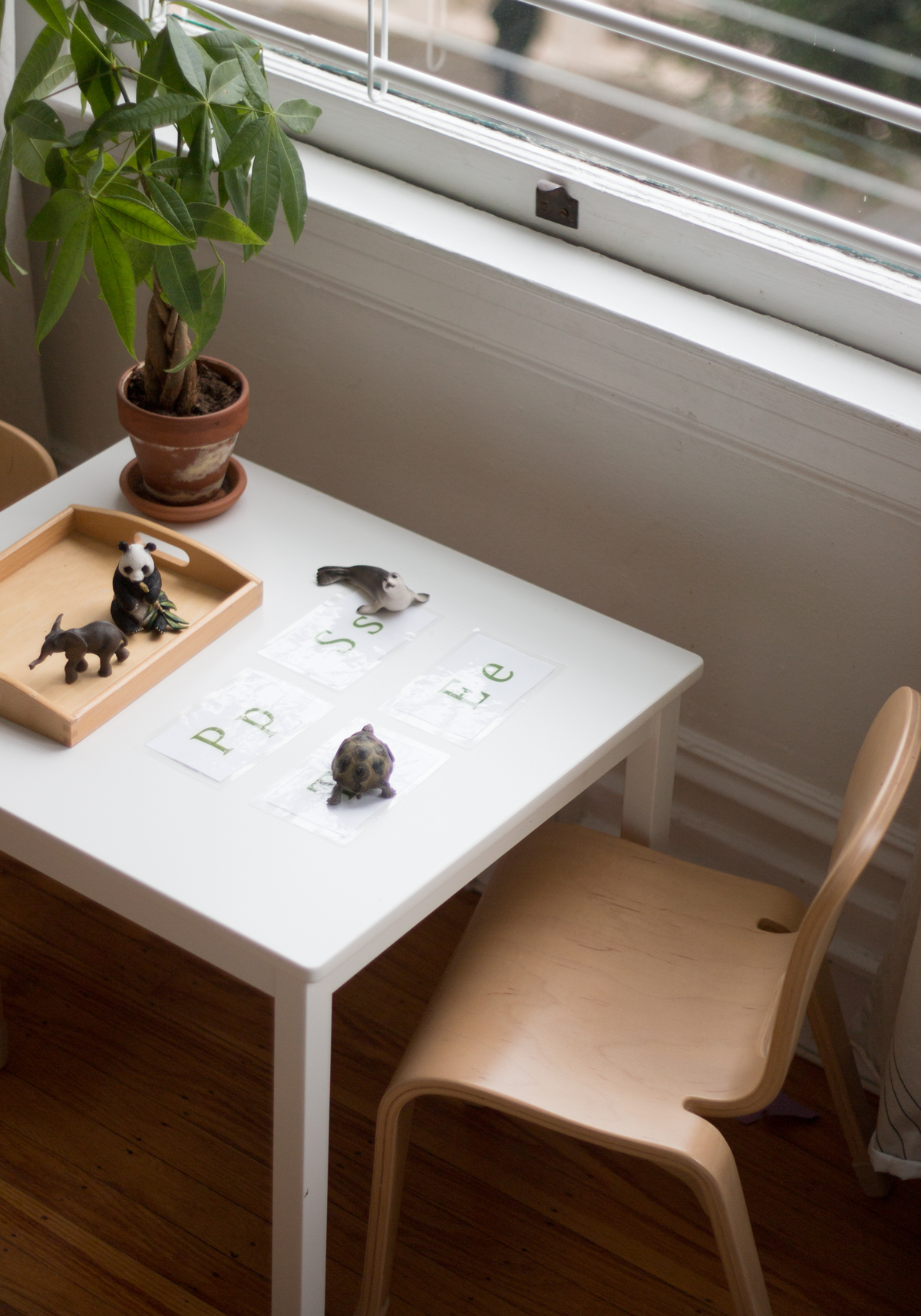I pulled together this phonetic language game for Bean today, and it was kinda fascinating.
In the Montessori world, you would provide a tray of language objects along with sandpaper letters, and walk the child through matching the beginning sound of an object with the coordinating sandpaper letter. You can buy wonderful sets of language objects online (at Montessori Services and Amazon), but looking through the photos, I thought I might be able to recreate that myself, using what we already have. (Because we have SO MUCH STUFF. No more stuff!)
(In Montessori, schools teach the phonetic sound of letters rather than the name. So, the letter S is referred to as “sssss” not “es.” The letter T is “tuh” not “tee.”)
At this stage in her life, a little over 3, Bean is fairly comfortable with identifying letter shapes. She’s been playing letter matching games for a while and like most households, we have letter puzzles and letter refrigerator magnets. Letters letters everywhere. I’ve been trying to figure out what comes next, and the language object matching game seemed like a logical next step. This will be her first introduction to the idea that words are a composite of letter sounds.
For our tray at home, I pulled together some of Bean’s miniature animals alongside some laminate letter cards I made last year, for the letter matching game. (You could alternately just print on card stock. Laminating made sense at the time because she was still in destructive toddler mode.) I chose her animals because she really really loves animals. If your kid is into something entirely different, you could probably create a language matching game out of those instead. Like, different types of trucks, different superheroes or princesses, etc. Anything that your kid knows the names of.
I started off with the letters she is most comfortable with — T, S, P, and E. I didn’t want her to get stuck on the letter sound itself and not be able to play the matching game. I also only started off with 4 letters and animals. I didn’t want her to feel swamped or overwhelmed. This is supposed to just be an introduction.

First, we laid out the cards, and we went through the sounds in order.
Next, I picked up an animal and asked, “what is this?” (This might only be appropriate for older kids, since I’m very confident that she knows the animals’ names. Here’s a short video on how a Montessori teacher would go through a language exercise with a child.)
Then, I asked her which letter she thought matched the first letter of elephant or sea lion, etc. When she placed the animal on a card, I would repeat “Eh, elephant.”
(Bean’s Montessori teachers have taught me to keep language games to a minimum of words. Put all the focus on the words and sounds you are trying to teach (eh, elephant) and nothing else. Saying things like, “yes! that’s right! elephant starts with e!” just muddies the waters and makes your kid do some mental gymnastics to extract the relevant sounds and words. Keep it simple, just focus on the sounds and words you want them to walk away with.)
As I said, it was fascinating to watch her try to process this new game. The magic of the Montessori method is its ability to isolate lessons. By isolating just one lesson here — not learning the alphabet itself, not learning names of things, not learning entire words — but just listening for the beginning sound of a word, I was finally able to measure how much she actually understands about the way language works.
And, also, just as when she was a small infant learning how to hold a rattle, I could see her mind just churning in on itself to learn something that seemed inherently known to me. We’re not born knowing how to hold a rattle? You didn’t know that balls roll downhill? Of course, elephant begins with “eh!” I love these moments, when I learn so much about the way her brain works.
This was hard work for her. It was just at the right level, challenging enough not to be boring, but not so challenging she walked away. She concentrated really hard on separating out the beginning sound of each animal. Eventually, she started watching my lips to see what sound I was making with my lips — a little visual to help out the aural — and then would curve her mouth into that shape before placing the object. It was just really really cool.
As she gets more confident with these letter-animal combinations, I’ll add in other animals and then maybe also cull objects from her dollhouse and other toy sets. I love how Montessori at home can really make an entire new game, all from the stuff we already have around the apartment.







